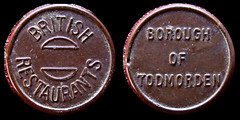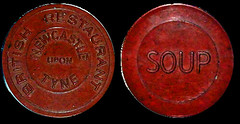
PREV ARTICLE
FULL ISSUE
PREV FULL ISSUE
FEATURED WEB SITE: BRITISH RESTAURANT TOKENSThis week's Featured Web Site is Philip and Harry Mernick's site on British Restaurant tokens. Philip writes:We (my tokens, Harry’s web skills) have a new web site for the tokens issued by the World War II period, local authority operated, restaurants known as British Restaurants From the site: British Restaurants were created from the Communal Feeding Centres set up by the Ministry of Food in badly bombed areas. They were officially created in 1941 and their numbers grew rapidly. On 19 April 1941 there were 246 in 129 towns. Number 1000 (Slough) opened on 23 August 1941 and by 1943 there were more than 2000. The aim was to provide a decent quality balanced meal for a reasonable price where normal food distribution has been disrupted. In some areas the British Restaurants were supplemented by similar establishments set up by the local authority. In London there was the Londoners’ Meal Service (Borough) and Civic Restaurants (London County Council). The restaurants were frequently housed in school buildings temporarily empty due to the evacuation of children to the countryside. Many stayed open after the end of hostilities, and in 1948 there were still 114 communal restaurants in London. When they were originally set up, various payment schemes were employed; but in June 1942 the Ministry of Food issued an instruction that ‘all schemes for British Restaurants submitted in the future should propose the use of plastic discs as tokens of payment for meals’. Authorities using paper tickets were asked to change to plastic. If a local supplier was not known, the Ministry could provide a list of firms who would supply suitable tokens. Included with this instruction were the details of how an unnamed, but obviously highly regarded, British Restaurant used its plastic tokens. There were different sizes for adults and children, and different colours for the various parts of the meals: red for meat, yellow for soup, green for sweet and brown for tea or coffee.


www.mernick.org.uk/brWayne Homren, Editor The Numismatic Bibliomania Society is a non-profit organization promoting numismatic literature. See our web site at coinbooks.org. To submit items for publication in The E-Sylum, write to the Editor at this address: whomren@gmail.com To subscribe go to: https://my.binhost.com/lists/listinfo/esylum All Rights Reserved. NBS Home Page Contact the NBS webmaster 
|